Article: Peter Horton, Messari Analyst
Translation: Luffy, Foresight News
Key Points:
- In the third quarter, the Solana ecosystem minted nearly 45 million compressed NFTs (cNFTs), representing a 316% increase compared to the previous quarter. Among these, the free collectible distributor DRiP accounted for 87.5% of the NFTs minted, followed by Dialect and Helium.
- Solana's Solana Virtual Machine (SVM) and general technology stack are attracting external attention and adoption. Rune posted an article exploring MakerDAO's Solana fork, L2 solution Eclipse announced support for SVM, and Visa integrated payment functionality on Solana.
- Solana's DeFi TVL increased by 32% to $368 million quarter-over-quarter. This growth was driven by the introduction of incentive programs by DeFi and liquidity staking protocols, with leading projects including MarginFi, Jito, Cypher, and BlazeStake, among others.
- By the end of the third quarter, the majority of clients had upgraded to version 1.16. This upgrade reduced validator memory requirements, introduced confidential transactions, and improved support for zk-proofs.
- Despite concerns about FTX liquidating over 57 million SOL tokens, SOL's market capitalization increased by 17% to $8.4 billion quarter-over-quarter. FTX/Alameda's SOL is subject to various unlocking schedules, with the full unlocking date expected around the fourth quarter of 2025.
Introduction to Solana
Solana is an integrated open-source blockchain aiming to synchronize global information at the speed of light. Solana is optimized for latency and throughput but sacrifices some verifiability. It seeks to achieve this goal through features such as a novel timestamp mechanism (Proof of History, PoH), block propagation protocol Turbine, and parallel transaction processing. Since its mainnet launch in March 2020, Solana has continuously improved network performance and resilience through multiple network upgrades, including QUIC, Quality of Service (QoS) weighted by stake, and on-chain fee market.
The non-profit Solana Foundation, Solana Labs, and other third-party organizations including Helius and Superteam collectively drive the development and growth of the Solana network and ecosystem. Solana Labs has raised over $335 million through private and public token sales. The Solana ecosystem encompasses an increasing number of projects across various domains, including DeFi, consumer, DePIN, payments, and privacy.
Key Metrics
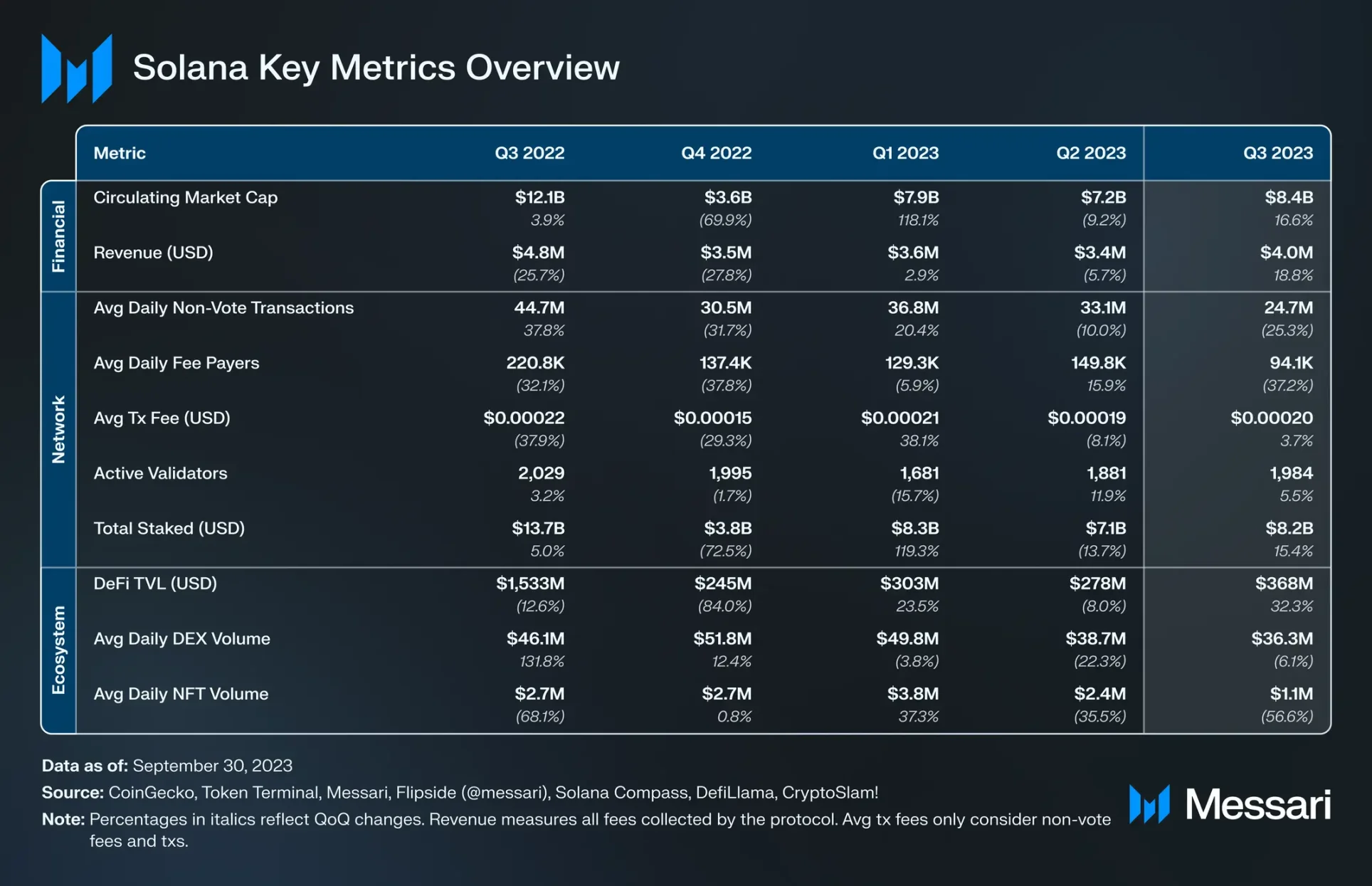
Financial Analysis
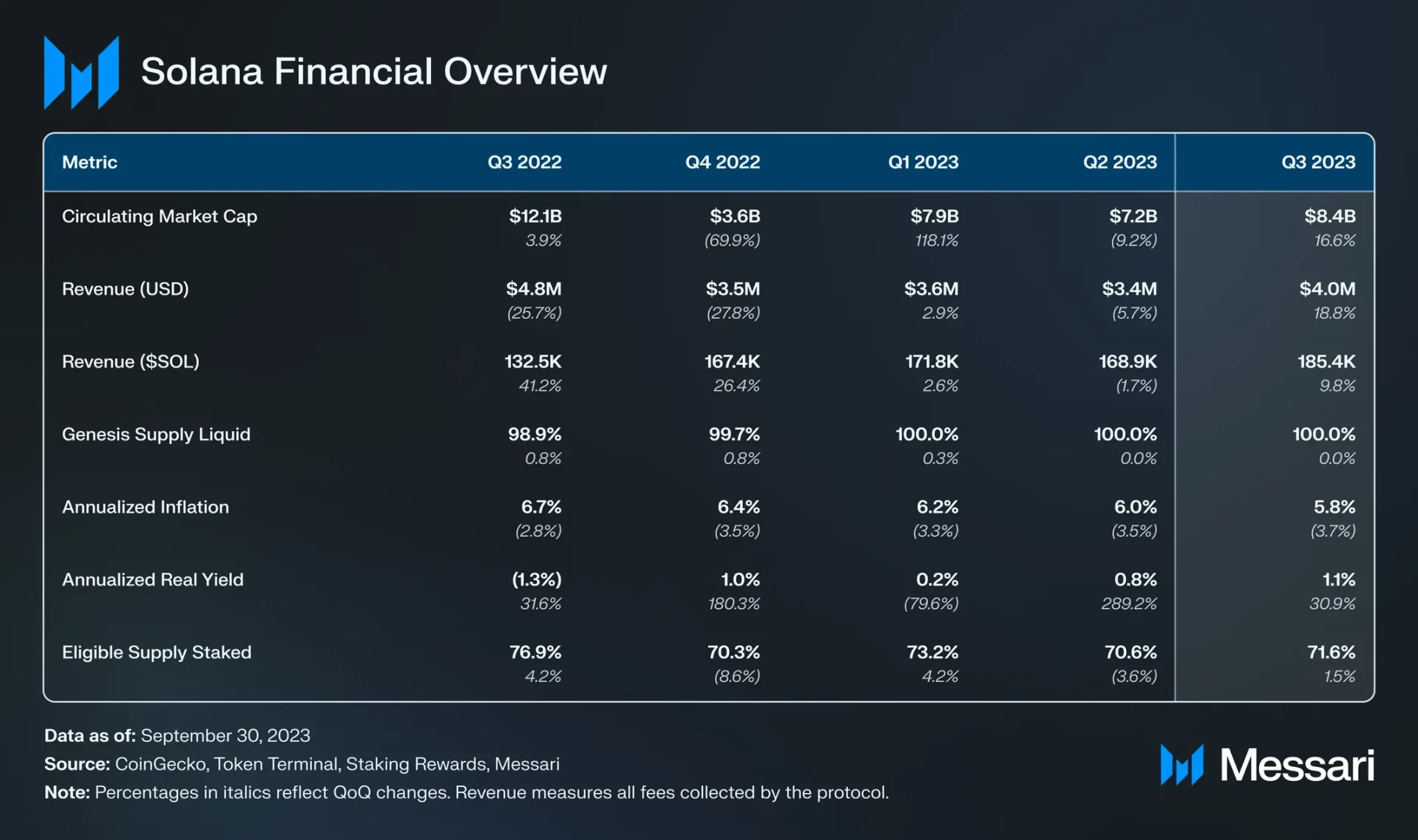

In early June, the SEC filed regulatory lawsuits against Coinbase and Binance, classifying SOL as a security asset, causing SOL's price to temporarily drop by 34%. However, SOL's rebound momentum at the end of the second quarter was stronger than other tokens classified as securities by the SEC, and this trend continued into the third quarter. After a brief dip due to concerns about Alameda/FTX's potential liquidation of SOL, SOL's market capitalization at the end of this quarter was $8.4 billion, representing a 17% increase quarter-over-quarter. Notably, SOL's performance surpassed assets of similar market capitalization, rising from 10th to 7th in market capitalization ranking.
Revenue in USD (all fees collected by the protocol) increased by 19% to $4 million, while in SOL terms, it increased by 10% to 185,400 SOL. In the Solana system, half of these fees are burned, and the other half is distributed to block producers. Currently, the burning of these tokens has not significantly reduced inflation, with SOL's inflation rate at the end of this quarter being 5.8%. This inflation comes from newly issued tokens for validator rewards and does not include other token unlocks.
SOL's inflation rate will decrease by 15% annually until stabilizing at 1.5%. As of the writing of this article, 71.6% of the eligible staked SOL supply is staked. It is important to note that tokens held by Solana Labs or the Foundation, while not locked, do not all count as circulating. With nominal yields higher than the inflation rate and not all tokens being staked, SOL's annualized real yield at the end of this quarter was 1.1%, representing a 31% increase quarter-over-quarter.
Although initially all allocated SOL was liquid, secondary trading of locked tokens (e.g., grants or token purchases) may create inflationary pressure. It is worth noting that Alameda and FTX purchased over 57 million SOL from the Solana Foundation and Solana Labs. However, these tokens are subject to various unlocking schedules and are expected to be fully unlocked around the fourth quarter of 2025 (locked token accounts can be sold in over-the-counter trading). FTX obtained approval to liquidate its cryptocurrency assets at a pre-trial hearing on September 13. Prior to the hearing, SOL experienced negative price movements, especially in the derivatives market. Open short positions increased significantly, pushing funding rates close to yearly lows. SOL rebounded at the end of the quarter and continued into the fourth quarter.
Network Analysis
Adoption
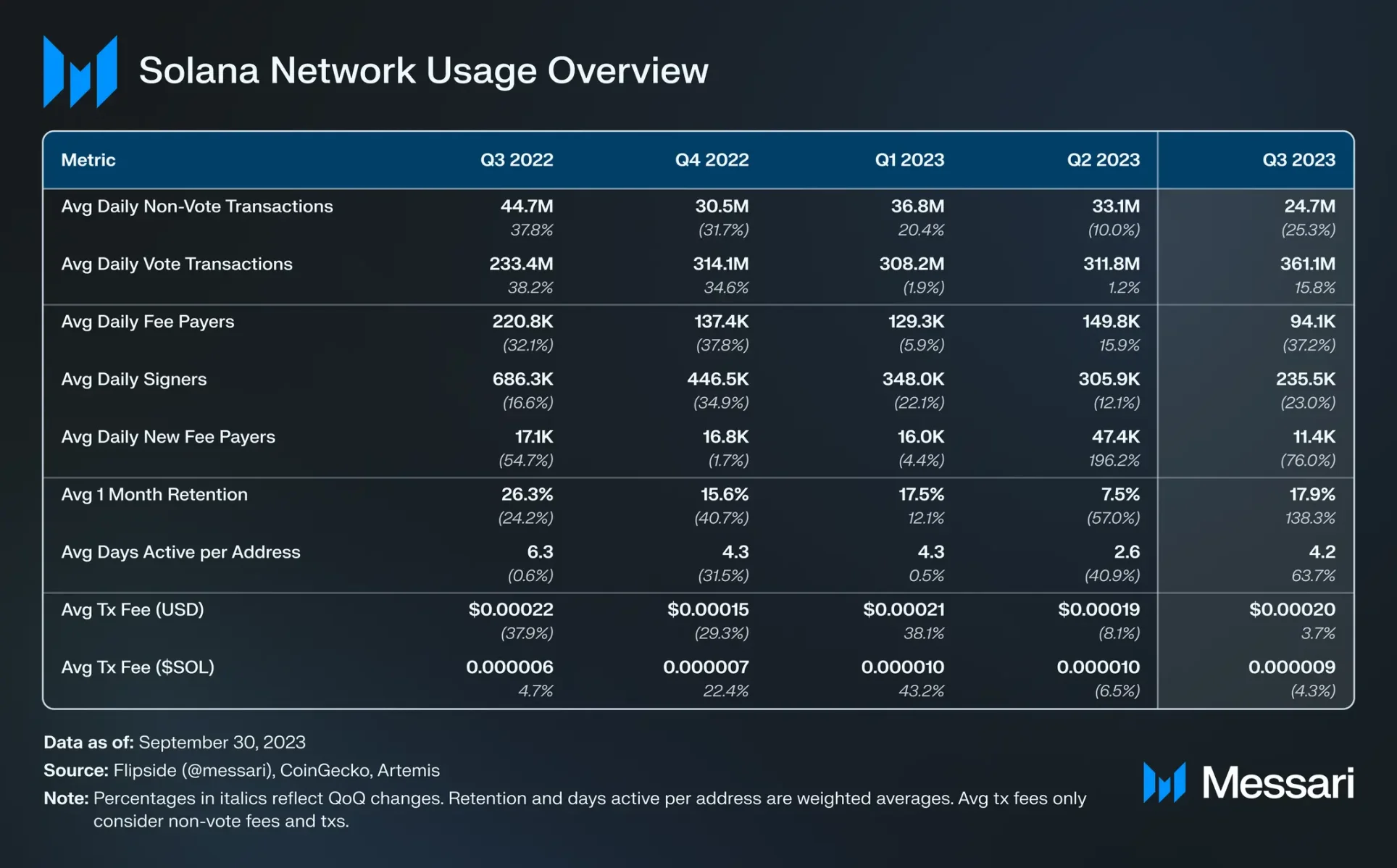

Measured by non-voting transactions and payers, network activity declined quarter-over-quarter to reach an annual low (excluding the network outage on February 25, 2023). The average daily non-voting transaction volume decreased by 25% to 24.7 million, and the average daily payers decreased by 37% to 94,100. In cases where applications subsidize end-user gas fees, the number of payers may not represent users. The average daily number of signers, including these users, decreased by a smaller margin than payers, down 23% to 235,500.

The average daily new payers decreased by 76% to 11,400 quarter-over-quarter. However, due to anomalous activity from an unknown program, the second quarter's data showed an increase, with a large number of new addresses created in mid-May. By June, these new addresses were no longer active, resulting in a low monthly retention rate of 2.5% for May. The average monthly retention rate for the third quarter was 17.9%, consistent with the previous year.

Solana transaction fees remain the most stable and cheapest among all blockchain networks. In the third quarter, the average fee per non-voting transaction was $0.0002. Priority fees reduce network spam transactions and work in conjunction with the on-chain fee market to prevent individual hot contracts from congesting the network. The percentage of non-voting transactions using priority fees has slowly decreased since many wallets and applications first integrated this feature in the first quarter of this year.
Security and Decentralization
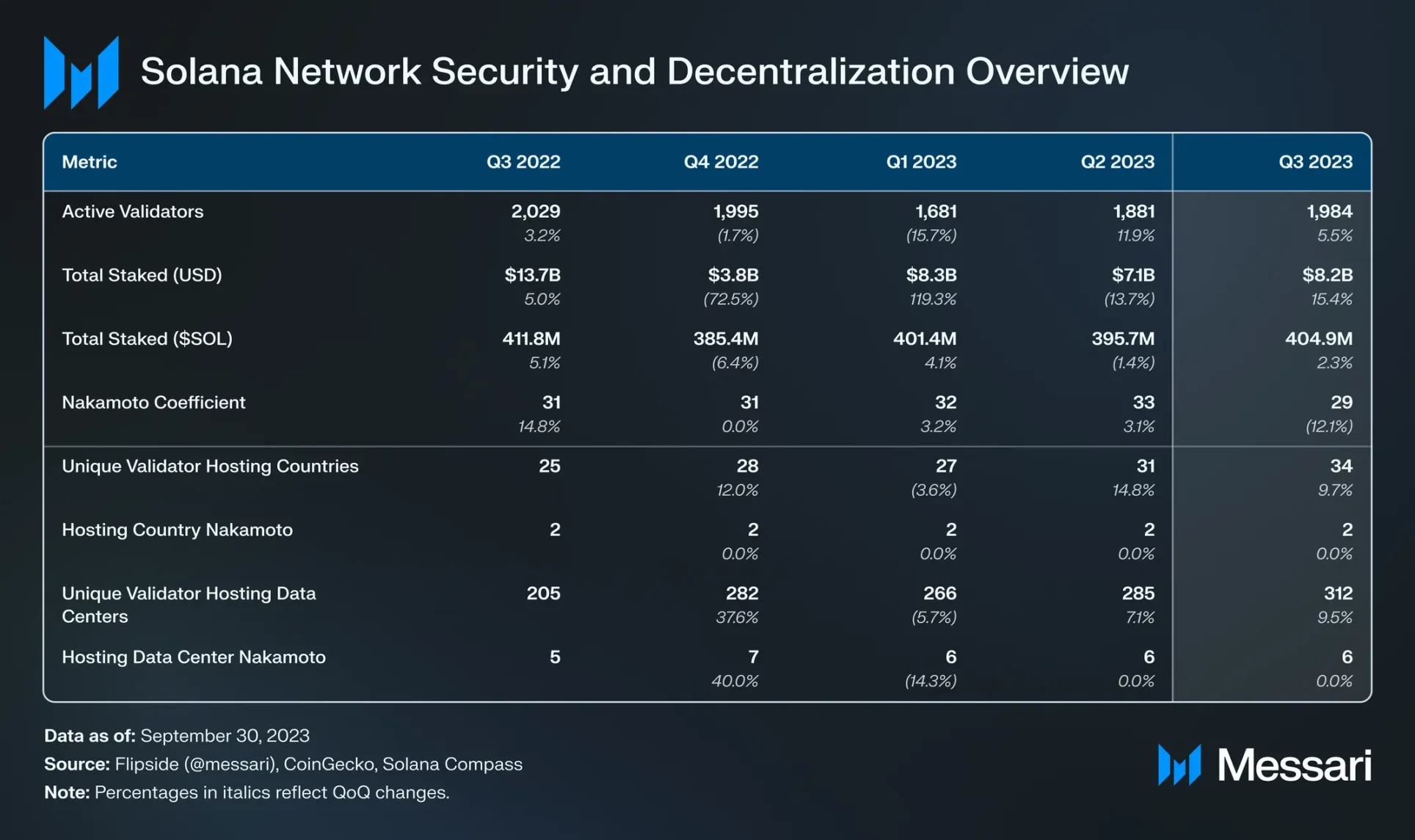
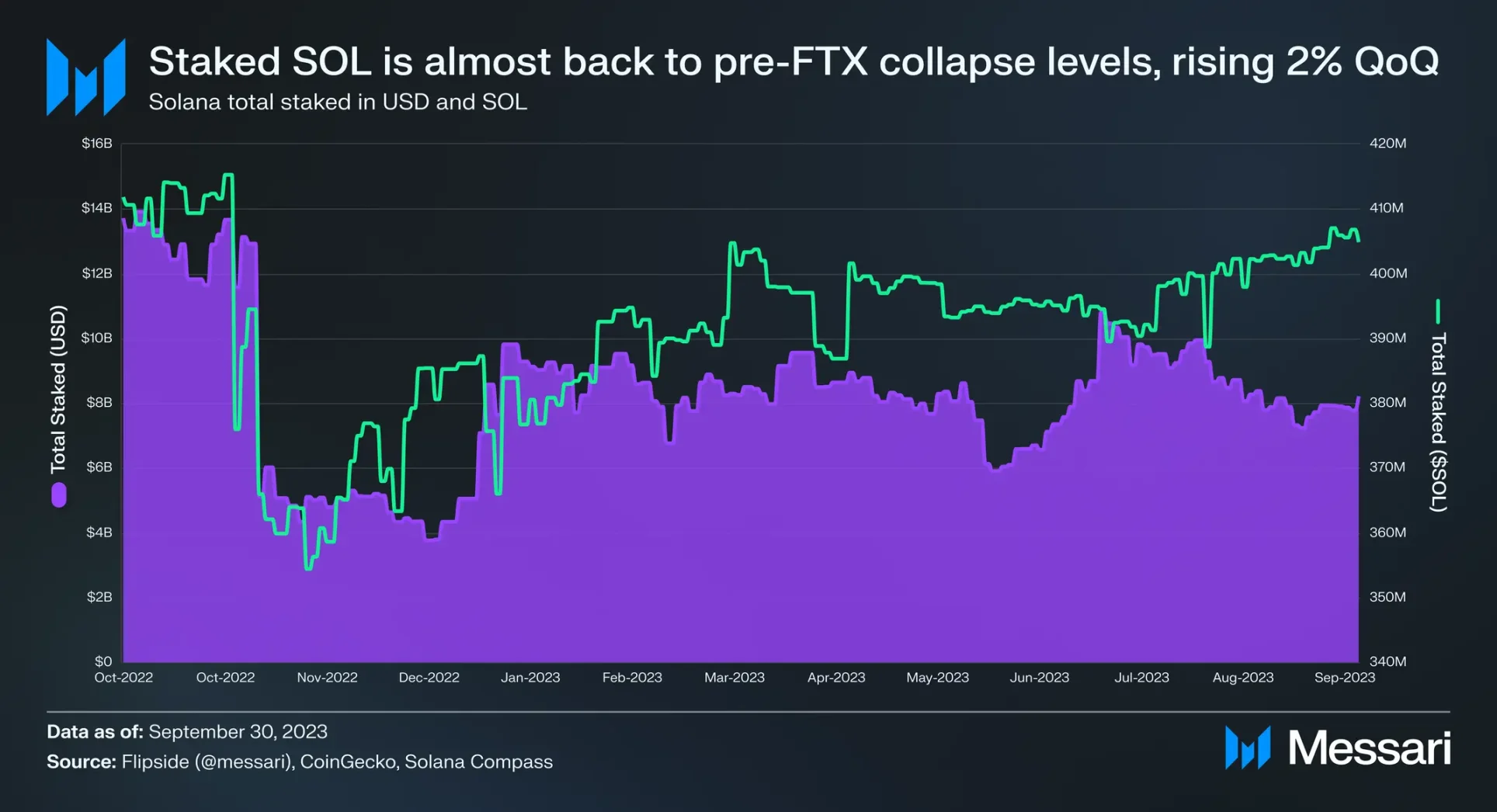
The total staked SOL increased by 2% to 404.9 million this quarter. In terms of total staked market value, Solana ranks second at $8.2 billion, second only to Ethereum. The amount of staked SOL has almost returned to the level before FTX's collapse.

Solana's Nakamoto coefficient decreased by 12% to 29 quarter-over-quarter but still remains industry-leading. The number of validators slightly increased by 5.5% to 1,984. The Solana Foundation indicated in its October validator report plans to make changes to the delegation program to encourage improving node quality, not just quantity. There are over 73 million SOL in the delegation program.
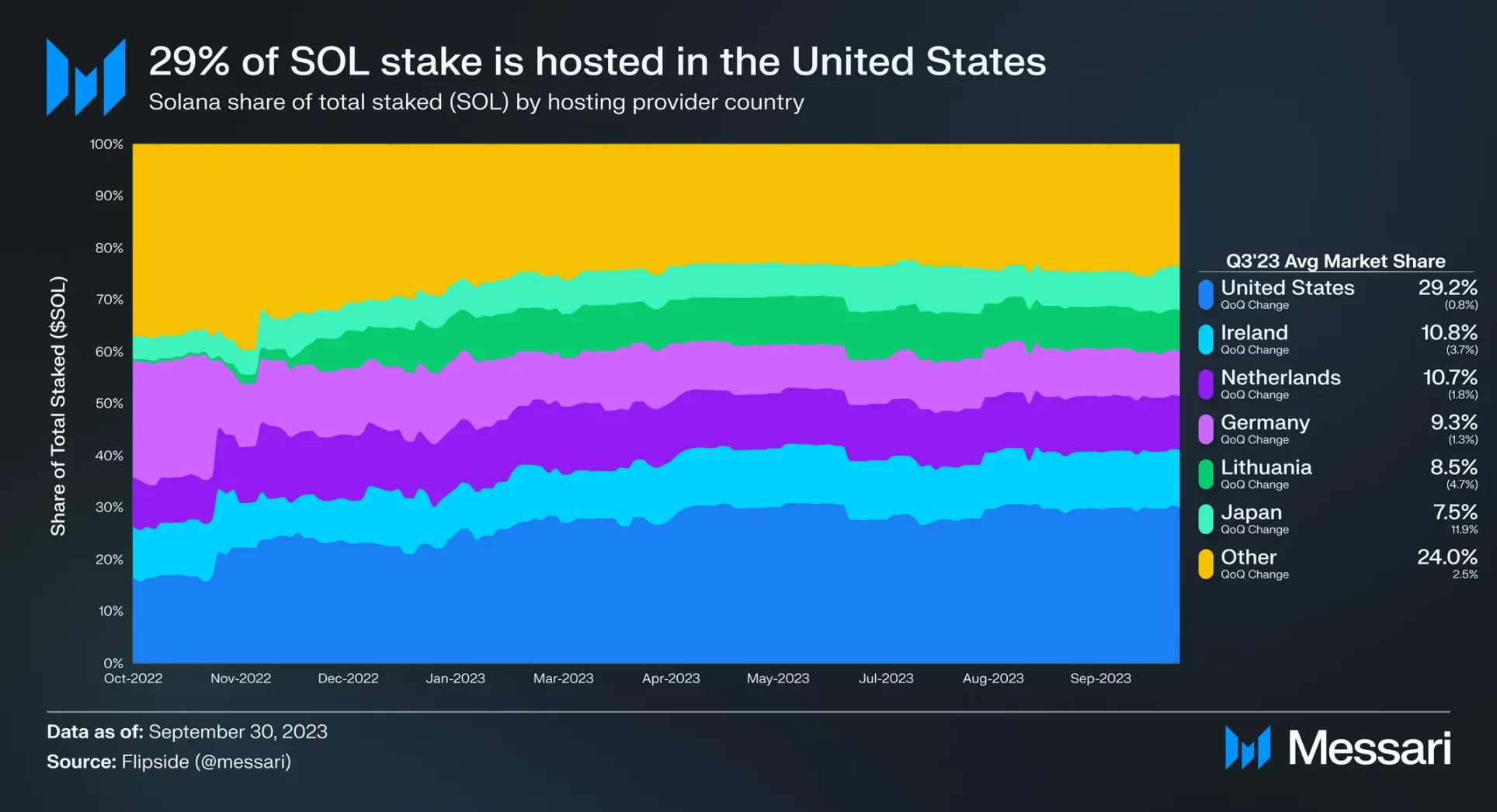
The Nakamoto coefficient is the minimum number of nodes required to stop the network or disrupt network activity. In addition to checking on all nodes, it can also be measured on other dimensions important for the resilience of the validator network, including stake distribution, hosting providers, and clients.
Solana validators are spread across 34 countries, with a 10% quarter-over-quarter increase and a 27% year-over-year increase. The United States leads with a 29% staking share, slightly below the 33.3% threshold, giving Solana a geographic Nakamoto coefficient of 2. The Solana Foundation noted in its recent validator report plans to address the issue of the U.S. staking share increasing to near the 1/3 threshold over the past year.
Solana validators are hosted in 312 independent data centers, with a 10% quarter-over-quarter increase and a 34% year-over-year increase. Solana's data center Nakamoto coefficient is 6.
As detailed in the validator report, the hosting provider Nakamoto coefficient for Solana is 3, consisting of TeraSwitch, AWS, and OVH.
Solana currently has two clients: the original Solana Labs client and Jito Labs' MEV optimized branch version. Shortly after the end of the third quarter, the Jito client gained over a third of the staking. However, it does not provide the same client diversity as the re-engineered client. For this reason, two clients are being rewritten from scratch: Firedancer and Sig.
Jump Crypto is developing Firedancer in C++. Toly acknowledges the difficulty in providing an engineering schedule and estimates that Firedancer will be tested on the testnet by the end of this year and go live on the mainnet approximately six months later. In addition to client diversity, Firedancer may bring performance improvements. It achieved over 1 million TPS in a test environment, while the Solana Labs client can only achieve about 55,000 TPS in a similar environment.
Sig is a new client announced at the end of July. Syndica is leading the development of Sig, which will be written in Zig. Sig is optimized for RPC reads, aiming to reduce Solana's slot latency. It also emphasizes readability and simplicity, hoping to be more accessible to developers.
Additionally, the lightweight client TinyDancer is also actively being developed. TinyDancer will allow users to verify the state without running a full node, increasing the network's trustlessness.
Finally, although difficult to measure, the Solana Foundation has noted a significant increase in participation in the validator network. Examples include monthly community-led validator conference calls starting in March 2023 and the Solana validator conference Block Zero, organized by the community in the fourth quarter.
Performance, Upgrades, and Roadmap
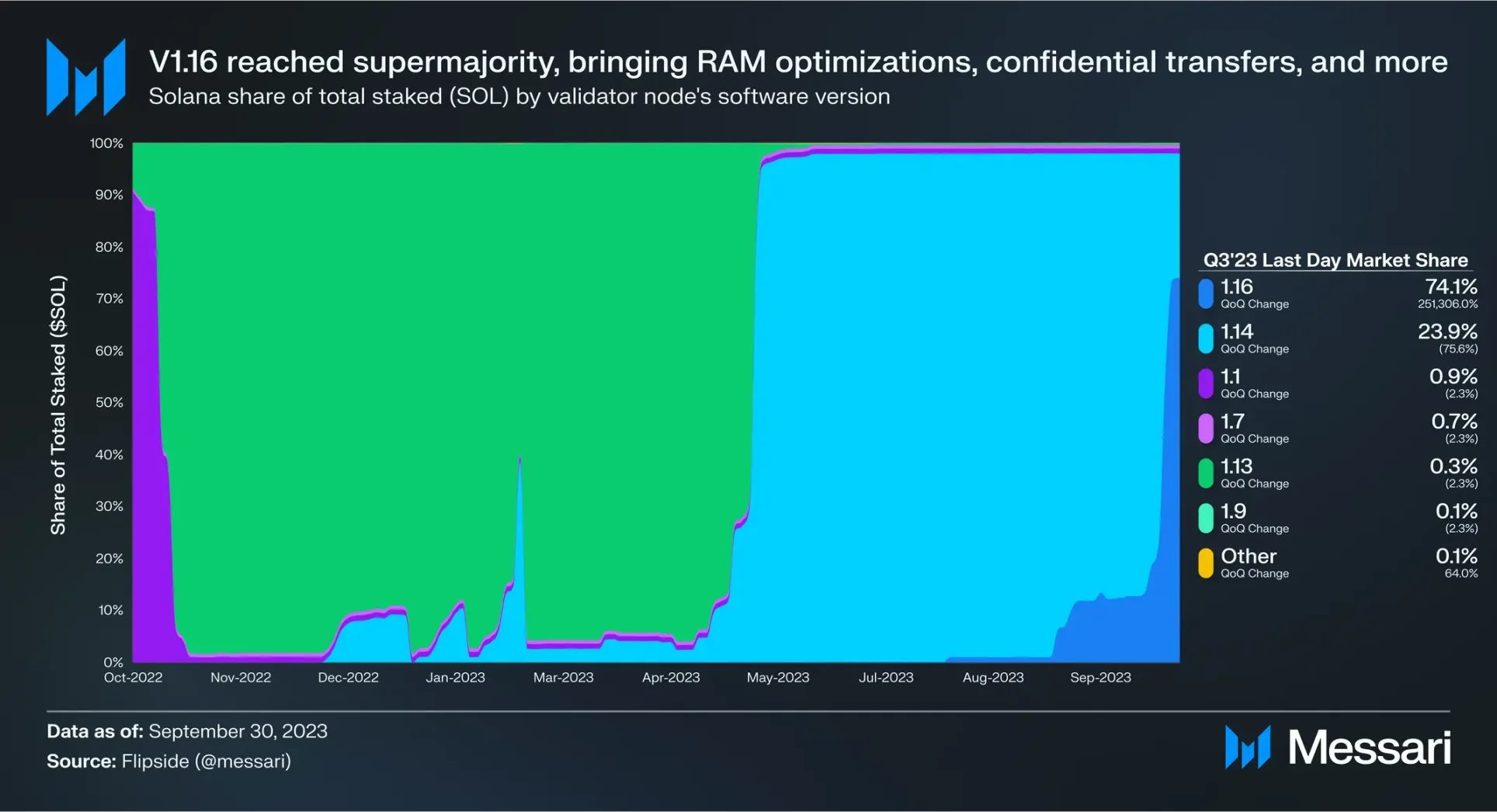
Solana network has been online since February 25th, and the continuous online time is approaching a historical high. This improvement is the result of upgrade process improvements and new technical features introduced last year, such as QUIC, stake-weighted service quality, and on-chain fee market.
The strong performance of SVM and the overall Solana technology stack has attracted attention from outside the Solana ecosystem. Some use cases of SVM outside of Solana include:
MakerDAO: One of the most surprising events in the third quarter was MakerDAO founder Rune's forum proposal exploring forking SVM to power the backend of the Maker protocol and its sub-DAOs. Rune pointed out that after extensive research, he believes Solana has the most promising codebase due to its technical quality, multiple client implementations, resilient ecosystem, and thriving developer community, as well as the history of forked applications like Pyth.
Eclipse: Eclipse, originally a Rollup as a service provider, announced in mid-September that it is pivoting to a general L2 powered by SVM. While some have tried to portray this as a victory for Ethereum at the expense of Solana, many members of the Solana community are optimistic about this news.
Rome: The Rome protocol, utilizing Solana's shared sequencer, was launched at the end of this quarter. The shared sequencer network will serve as the smart contract deployment on Solana, with each Rollup using its own deployed Neon EVM.
Neon EVM, the EVM engine for smart contract deployment on Solana, was launched on the mainnet in mid-July. The network has an average daily transaction volume of about 22,000, but over 80% of the total transaction volume came from four days of peak activity. Neon received some criticism from the Solana community members at its launch due to its token economics.
Two days after Neon's launch, Solana Labs released the Hyperledger Solang compiler, allowing developers to write Solana programs in Solidity. While Neon allows developers to write EVM contracts that can run on Solana, Hyperledger Solang allows developers to write Solana programs using Solidity, but not Rust or C.
Ecosystem Analysis
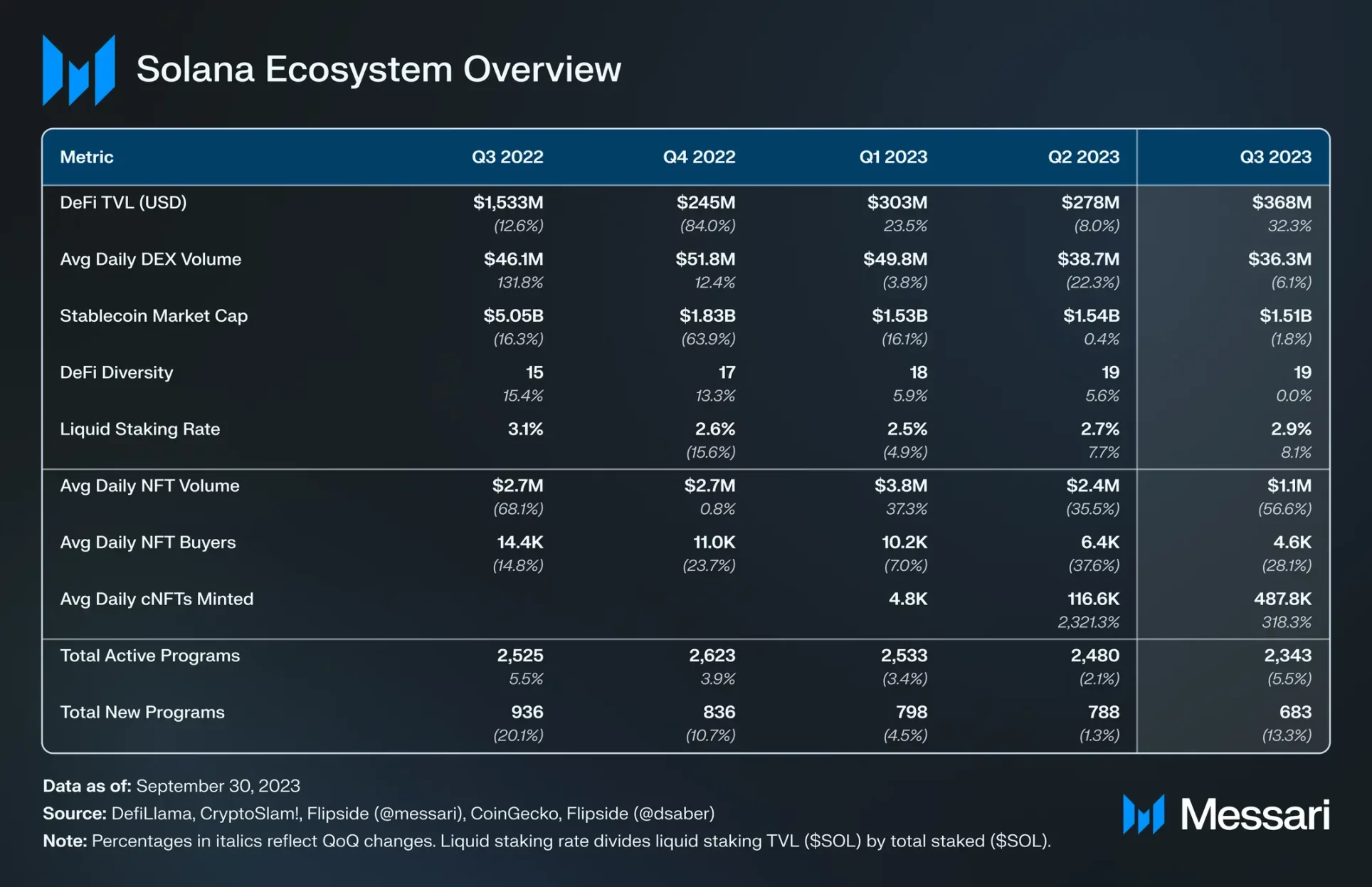
DeFi
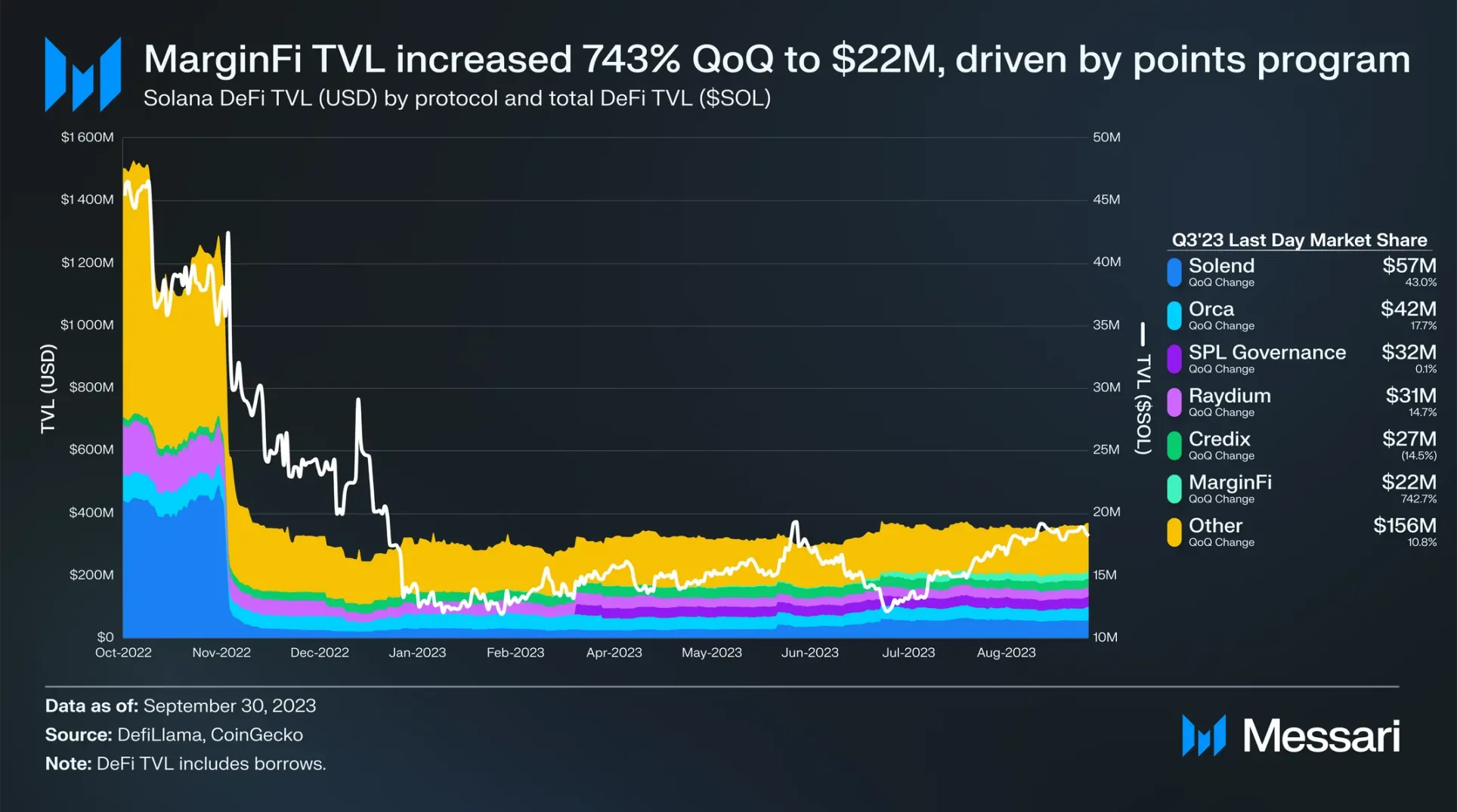
In the past few quarters, there has been significant growth in new DeFi protocols self-proclaimed as "Solana DeFi 2.0". This label represents a commitment to avoiding the predatory, low-circulating token economics that were prevalent in the previous cycle. Additionally, most of these protocols have not yet launched native tokens.
One of the leaders in this trend is the lending protocol MarginFi. On July 3rd, MarginFi introduced a point system, offering rewards to users for deposits, borrowing, and referring other users. In the third quarter, its TVL grew by 743% quarter-over-quarter, ranking sixth among Solana protocols with a TVL of $22 million. At the end of this quarter, MarginFi launched its own liquidity staking token LST, which is further explained in the liquidity staking section below.
Perpetual contract trading platform Cypher introduced a point system in mid-July. Cypher is one of the fastest-growing DeFi protocols on Solana and suffered an attack worth about $1 million in early August. From IDO to airdrop, over 50% of CYPH will flow to the community.
Solana DeFi lending protocol Solend introduced a point program in early August. Solend did not use the points for potential airdrops but linked the points to its already launched token SLND. The first season of Solend's point rewards will last for about three months, with a minimum reward pool of 100,000 SLND (worth $54,000 as of September 30, 2023). Driven by the point system, Solend's TVL grew by 43% quarter-over-quarter to $57 million.
Other notable DeFi developments include:
- Phoenix Launch: After releasing a test version in March, the fully on-chain limit order book trading platform Phoenix officially launched at the end of August. In the week leading up to the August release, the Phoenix development team, Ellipsis Labs, announced a $3.3 million seed round led by Electric Capital. Since its launch in August, the most popular trading pair on Phoenix, SOL/USDC, has had a daily average trading volume of over $3.4 million. Despite having a lower TVL compared to other exchanges, Phoenix remains the most popular market for this trading pair based on trading volume. As of the end of this quarter, Phoenix's TVL is $378,000.
- Drift Growth: Among the top Solana protocols, perpetual DEX Drift was one of the fastest-growing protocols in the third quarter. At the end of this quarter, its TVL was $17.3 million, an 87% increase quarter-over-quarter and a 976% increase year-to-date. Drift underwent several notable upgrades throughout the quarter, including Drift liquidity providers, market maker incentives, and MetaMask Snap CONNECT. The CONNECT upgrade allows users to trade on Drift and supports MetaMask cross-chain from EVM to Solana, with over 1,000 downloads to date.
- Solflare Snap: The Solflare wallet also launched MetaMask Snap, with nearly 19,000 downloads. Snap allows users to store Solana tokens and NFTs, cross-chain from EVM to Solana (supported by deBridge), and access Solflare-supported Solana applications (all through MetaMask). Solflare also launched the incentive program SolScout, offering a total of $100,000 in rewards to users who complete daily ecosystem-related tasks through Solflare or its MetaMask Snap.
- Jupiter V3: The trading aggregator Jupiter launched V3 at the end of July. It uses the new routing algorithm Metis, providing a better price discovery mechanism. Jupiter also introduced limit orders, USD cost calculations, and a cross-chain comparator. Based on active addresses and trading volume in the third quarter, Jupiter is one of the top DeFi protocols on Solana.
- Maple Returns: Following FTX's collapse and halt of development on Solana, Maple Finance returned to Solana in early September, bringing cash management solutions. The product offers U.S. Treasury yield to DAOs and high-net-worth individuals (with a 0.5% management fee). As of the end of this quarter, Maple's TVL on Solana reached $4.2 million.
- Circuit Launch and Funding: In August, Circuit launched the internal test version of Circuit Vaults and subsequently announced a funding round, with participation from Multicoin and others. Circuit collaborates with Drift, allowing users to deposit funds into the Supercharger Vault to access Circuit's Delta-neutral automated market maker strategy deployed on Drift.
- Additional developments include tBTC integration, Credix's USDC accounts receivable pool, Kamino Creator Vaults (Kamino also launched Kamino Lend shortly after the end of the quarter), Zeta V2, and the release of the EUROe stablecoin.
Liquidity Staking
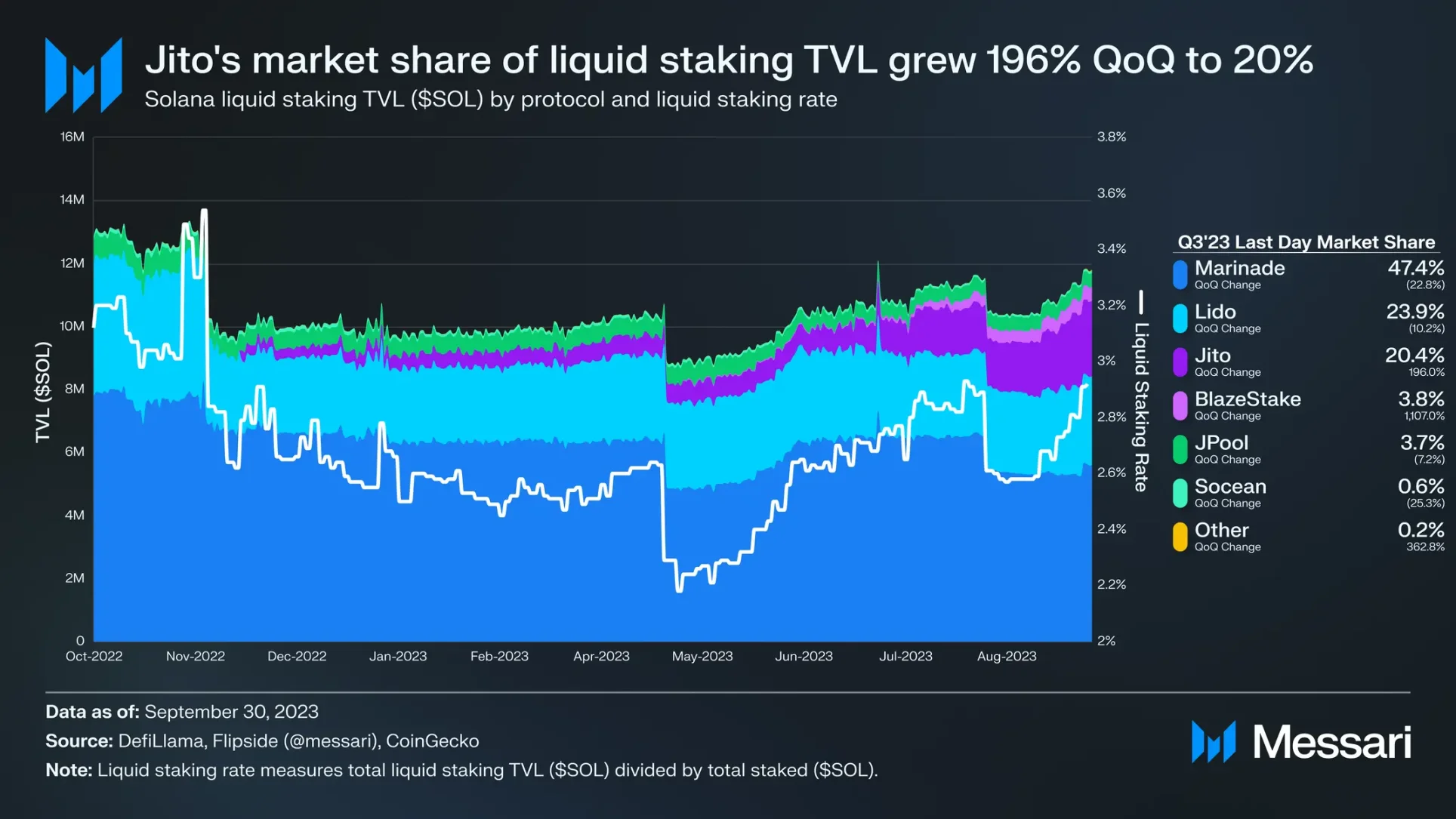
Due to the high SOL staking rate and low liquidity staking rate, a large amount of SOL has not participated in the ecosystem. Liquidity staking protocols have been seeking to improve this through incentive programs.
Since last year, the liquidity staking protocol Blaze has been airdropping to bSOL holders. In early August, it introduced a point system, offering point rewards to bSOL holders, and using bSOL in DeFi protocols for higher rewards. Shortly after, Blaze launched its token BLZE and began airdropping based on user points, with 64.5% of the BLZE supply allocated through initial airdrops and ongoing rewards to users. Blaze's TVL in SOL grew by 1,234% quarter-over-quarter to 452,000 SOL (worth $9.2 million as of September 30, 2023).
Following the launch of a referral program at the end of August, Jito introduced a point system in mid-September. Similar to Blaze, Jito rewards JitoSOL holders and increases their DeFi activity point rewards. Jito's TVL in SOL grew by 227% quarter-over-quarter to 2.4 million SOL (worth $48.8 million as of September 30, 2023). As of the end of this quarter, about 35% of JitoSOL is deposited in the program rather than in wallets, compared to 13% at the beginning of the quarter.
Similar to the DeFi ecosystem, the liquidity staking giant Marinade, which has issued tokens, launched a reward program in mid-September, attempting to keep up with the growth of new protocols. Marinade's TVL in SOL slowly declined throughout the quarter but began to rise again after September 20. Marinade also launched Marinade Native at the end of July, a native staking product to complement Marinade's liquidity staking. Marinade Native is an equity automation platform that routes equity to over 100 top-performing validators, without fees and without introducing any smart contract risk.
As mentioned, MarginFi launched its own liquidity staking token, LST, at the end of this quarter. LST distributes equity to three validators operated by the MarginFi team. It differs from other liquidity staking providers in that it sacrifices a certain degree of decentralization for higher staking yields. All three validators use the JitoLabs client and allocate all MEV uplift rewards to LST holders. The MarginFi team has also hinted at introducing stablecoins supported by LST.
At the end of the quarter, Lido proposed to stop or update its funding on Solana. Ultimately, the community voted to stop. With Lido occupying nearly 24% of the liquidity staking TVL market share at the end of this quarter, this presents a significant opportunity for other protocols to absorb its share.
Protocols like Super Stake and Sanctum are further enhancing the liquidity staking ecosystem. Super Stake launched at the end of the second quarter, using recursive borrowing strategies on Drift to amplify LST yields. It added support for JitoSOL in the third quarter, joining mSOL. Currently, both vaults have reached their limits. Sanctum (formerly unstake.it) provides liquidity and stability for Solana's liquidity staking and DeFi ecosystem. It offers instant liquidity for staking SOL and a "haven" SOL pool for quickly closing LST collateral loan positions.
While liquidity staking protocols are competing for market share, they are all working towards the same goal of increasing the Solana liquidity staking rate. In addition to incentive programs, the Solana Foundation's partial native staking SOL transfer to liquidity staking SOL could significantly increase this ratio, and the foundation is working on this plan.
Consumer Sector
NFT

Following the surge from the Solana Monkey Business lottery event on the last day of the second quarter, the daily average NFT trading volume on Solana decreased by 57% to $1.1 million quarter-over-quarter, with a decrease in sales and unique buyers.
Notable NFT developments in this quarter include:
- Mint events for Tensorians, Meegos, Reavers, Gates of BroHalla, and VTOPIANS.
- On September 23, the NFT series of a virtual horse racing game, Photo Finish LIVE, which has been around for over two years, became the top-ranked Solana NFT series by in-game market value. This was likely driven by the anticipation of the fourth virtual Kentucky Derby (officially licensed) scheduled for September 23. However, by the end of this quarter, "Mad Lads" reclaimed the top spot for the highest market value NFT.
- Magic Eden regained most of Tensor's market share at the end of this quarter. Tensor's market share was 1.2% at the beginning of the year and reached over 74% in early August.

Source: Top Ledger
In early second quarter, Solana introduced state compression. This upgrade provided an economically efficient way to store data on-chain by hashing data into Merkle trees and publishing Merkle roots on-chain. Its first major use case was the compressed NFT (cNFT) standard created by Metaplex. The cost to mint and store 1 million cNFTs ranged from 5.3 to 63.7 SOL, depending on the composability level, compared to the uncompressed cost of 24,000 SOL.
Nearly 45 million cNFTs were minted in the third quarter, a 316% increase quarter-over-quarter. DRiP accounted for 87.5% of these cNFT mintings. DRiP collaborates with artists to offer free art NFT minting, with series sizes much larger than the usual 10,000. In mid-August, DRiP announced a $3 million seed round led by Placeholder.
Dialect is another leading cNFT use case. Dialect is a Web3 messaging app that uses cNFTs as Dialect stickers. In early September, Dialect launched its app.
As mentioned, Tensor launched its own Tensorian cNFT series in August. Users needed Tensorian shards to mint Tensorians, with these shards airdropped to users as part of the second quarter rewards. The total trading volume for Tensorians and Tensorian Shards in the third quarter was approximately $7 million.
Since its launch in May 2023, Tensor has become the primary market for cNFT trading. However, Magic Eden is seeking to change this and added cNFT support in mid-September. Since Magic Eden integrated cNFTs, Tensor has retained almost all market share, accounting for 97.2% of the total.
In early September, developer kiryl introduced a tool for multiple cNFT burns, creating a new use case. The "Burning Man" task in September incentivized burning specific cNFTs for rewards.
Gaming
In addition to Photo Finish LIVE, other notable gaming developments include:
- Star Atlas SAGE Labs: Star Atlas launched the open-world game SAGE Labs for early access in late September, allowing users to compete for $1.2 million in prizes. As all operations occur on-chain, SAGE drove a significant increase in Solana's total trading volume.
- Bonk SVB: On August 1, meme coin Bonk launched Silicon Valley (SVB) BONK, a on-chain lottery game where users compete to be the last person to purchase a key, with the winner receiving a portion of the funds from key purchases.
- The Heist Season 2: The popular game The Heist returned for its second season in mid-August, introducing new in-game currency and NFT series. Mobile support was added in mid-September. "Heist" led all NFT series in sales in the third quarter.
Social
One of the hottest narratives in the cryptocurrency space in the third quarter was friend.tech, showcasing the potential for social applications to become a breakthrough use case for cryptocurrency. Social applications on Solana include:
- Access Protocol: Access is a creator monetization platform. The third quarter saw the addition of 21 creators, bringing the total to 38. The number of subscribers doubled quarter-over-quarter to reach 227,000.
- Solarplex: Web3 social media platform Solarplex opened its V2 experience in mid-August, gaining initial attention.
- SolLinked: In mid-August, Solana Labs co-founder Anatoly Yakovenko tweeted about the "LinkedIn version of Friend.tech." A little over a week later, developer darksoulsfanlol made it a reality. SolLinked allows users to set prices for email replies or calendar bookings and accept payments in-app using TipLink and USDC.
- Friendzy: Friendzy is a more traditional fork of friend.tech, although account keys can be traded before the account owner activates them. After launching in mid-September, Friendzy reached a peak of $190,000 on September 26, but ended the quarter at $76,600.
- Hub3: Hub3 is another derivative product of friend.tech, adding features such as group chats, discovery tools, and NFT whitelist services. It launched on September 24, with activity picking up after the end of the quarter.
DePIN
Solana is becoming the center for DePIN applications, including Helium, Hivemapper, Teleport, Render (planned to migrate to Solana), and GenesysGo.
Notable events in the third quarter include:
- Helium: Helium is a decentralized wireless network that migrated to Solana in April 2023. In mid-August, Helium Mobile, which utilizes the network, launched a $5 per month unlimited calling plan, initially limited to residents of Miami.
- Hivemapper: Hivemapper aims to create a decentralized global map. At the end of August, it launched Hivemapper Bursts, providing additional HONEY rewards for mapping hotspots requested by customers. In the third quarter, Hivemapper mapped over 1 million miles of road, bringing its total mileage to over 3.3 million miles.
Payments
Payments are another emerging use case on Solana, with significant developments in the third quarter, including integrations with Visa and Shopify.
In early September, Visa announced the expansion of its USDC settlement pilot to Solana (previously on Ethereum). The Visa Crypto team published an in-depth study of Solana, emphasizing their belief that Solana can help drive mainstream payment processes, including the low and predictable fees provided by Solana's native fee market, parallel transaction processing, fast transaction finality, a large number of nodes, and multiple validator clients.
At the end of August, Solana Pay integrated with Shopify, allowing Shopify merchants to accept Solana native USDC payments. Shopify accounts for approximately 10% of total US e-commerce volume, and now merchants can use Solana payments to reduce expenses compared to standard credit card fees (1.5%-2.5%).
Other notable payment developments include:
- TipLink Gift Cards: TipLink allows users to send Solana tokens through links. In mid-September, it added the ability to purchase gift cards using cryptocurrency, providing an entry for users to receive cryptocurrency through links.
- Beam: Offramp Beam launched in mid-August, supporting Solana and several other networks. It then released an SDK at the end of the month, allowing developers to easily integrate the solution into their applications.
- CandyPay Mobile SDK: CandyPay allows applications to use tokens on Solana at checkout. In mid-August, it launched the mobile SDK.
- Meso SDK Early Access: Meso opened early access to its SDK, allowing developers to integrate its gateway product into their applications.
- Helio and WooCommerce: Multi-chain payment platform Helio partnered with WooCommerce in early September to support cryptocurrency payments on WordPress. A week later, it launched its self-hosted Solana wallet, allowing users to log in using email or Web2 social accounts.
Privacy
Solana has seen increasing support for privacy protocols. In addition to the core zero-knowledge (ZK) upgrade in V1.16, developments in the third quarter include:
- Light Protocol: Light Protocols is a zero-knowledge layer for building Private Solana Programs (PSPs) on Solana. Light Protocol uses a UTXO-based privacy approach. It also uses private state compression, so the cost of private transactions is the same as regular Solana transactions. In early August, it released the first PSP reference implementation.
- Elusiv: Elusiv is another privacy support layer using a shared pool approach. At the end of August, Elusiv launched token transaction privacy, using temporary keys to unlink a user's public key from their transactions. Elusiv leverages Jupiter liquidity.
Development
Resources and infrastructure built by Solana Labs, as well as independent companies like Helius and Ironforge, further promote ecosystem development.
Notable developments in the third quarter include:
- GameShift: Solana Labs released the GameShift API in mid-July, aiming to simplify Web3 game development.
- Helius Pyre: In mid-July, Helius launched Helius Pyre, an open-source platform for gamified learning of Solana development. Helius also released Test Drive, a Postman-like open-source tool for testing RPC through documentation and examples.
- Solana Courses: freeCodeCamp released a free developer course guiding developers to build 15 projects to familiarize themselves with building on Solana.
- Synthetic Asset Platform: Solana Labs released an open-source reference implementation of a synthetic asset platform near the end of this quarter.
- Other developments: Graph integration, Ironforge's Playground, four new Solana development courses, Ellipsis' validation building tool, and Magicblock's gas-free RPC API for games.
Ecosystem Growth
The grants, hackathons, accelerators, and other initiatives initiated by independent organizations such as the Solana Foundation, Lamport DAO, and Superteam further promote ecosystem development.
Notable events in the third quarter include:
- OPOS Hackathon: The OPOS (The Only Possible on Solana) hackathon was organized by Lamport DAO in August. Over 600 participants competed, receiving $100,000 in prizes from 40 sponsors across 25 tracks. The top prize winners were Onda Protocol ($10,000, State Compression track) and Ned Finance ($10,000, Jupiter track).
- Hyperdrive Hackathon: The Solana Foundation's online Hyperdrive hackathon began in early September. As of October 15, over 5,000 builders are competing for up to $1 million in prizes across seven tracks.
- Hacker Houses: The Solana 2023 Hacker Houses, sponsored by Jump Crypto, Circle, and the Solana Foundation, provided a space for developers to build, find collaborators, and learn from community members. This quarter, Hacker Houses were held in Berlin, Bangalore, and Mumbai.
- PlayGG: The Solana Foundation hosted the PlayGG gaming festival in mid-July. The event featured demos, live streams, tournaments, and workshops, focusing on dozens of games built on Solana.
Additional activities include the release of the Layer3 task platform, Solana Summer Fest, a conference on hosting Solana developer workshops, the Demo Day of the accelerator Solana University, and the Monacode Hackathon.
Upcoming events in the fourth quarter include the annual Solana Breakpoint conference, Hacker Houses in Hong Kong, the Solana accelerator by Encode Club, and the Berlin Demo Day.
Considering the bear market, the growth of the Solana ecosystem in the third quarter was significant, covering DeFi, liquidity staking, consumption, DePIN, and privacy protocols. Compressed NFTs (cNFTs) are becoming a popular use case for state compression, with nearly 45 million cNFTs minted in the third quarter, representing a 316% increase compared to the previous period, with free collectibles dealer DRiP accounting for 87.5% of these mintings. Contrary to market trends, Solana's DeFi TVL increased by 32% to $368 million compared to the previous period. This growth was primarily driven by incentive programs launched by DeFi and liquidity staking protocols, led by projects such as MarginFi, Jito, Cypher, and BlazeStake.
Solana's underlying technology is also gaining attention and adoption. Examples in the third quarter include Rune's exploration of MakerDAO's Solana fork, Eclipse's launch of L2 support for SVM, and Visa's payment integration on Solana. Additionally, Solana's technology continued to improve in this quarter. The V1.16 upgrade reduced validator memory requirements, introduced confidential transfers, and improved support for zk-proofs.
Finally, the market capitalization of SOL increased by 17% to reach $8.4 billion compared to the previous period. Despite concerns about FTX liquidating its over 57 million SOL tokens (the company received approval for this in mid-September's pre-trial hearing), the market capitalization of SOL still achieved growth. FTX/Alameda's SOL is subject to various unlocking schedules, with the unlocking dates extending to the fourth quarter of 2025. This means that locked tokens can still be sold in over-the-counter trading. Nevertheless, the Solana network and ecosystem are preparing to bid farewell to the bear market, with momentum stronger than when entering the bear market.
免责声明:本文章仅代表作者个人观点,不代表本平台的立场和观点。本文章仅供信息分享,不构成对任何人的任何投资建议。用户与作者之间的任何争议,与本平台无关。如网页中刊载的文章或图片涉及侵权,请提供相关的权利证明和身份证明发送邮件到support@aicoin.com,本平台相关工作人员将会进行核查。




